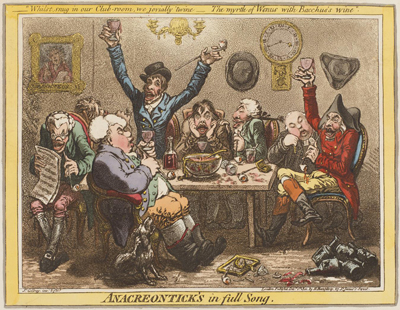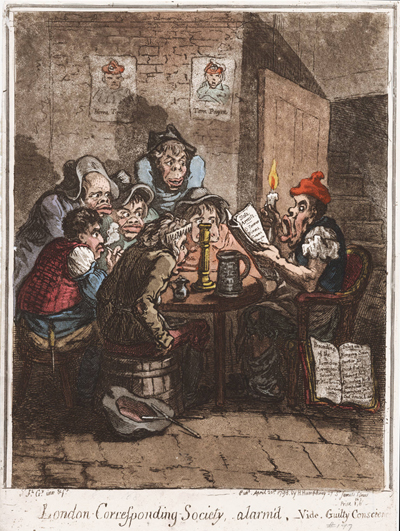Anacreontick's in Full Song
Anacreontick's in Full Song purports to show members of the Anacreontic Society concluding a long evening of festivities at 3:40 AM with the singing of their official song. The hunched figure on the left is in fact reading from sheet music labeled "Anacreontic Song" and two of the lines are quoted in the margin above the print image.
Whilst snug in our Club-room, we jovially 'twine
The myrtle of Venus with Bacchus's wine.

© Lewis Walpole Library, Yale University
Anacreon was a Greek poet of light lyrics and odes usually on the subjects of wine, women, and song. In Gillray's print, his portrait is on the wall on the left. As it was commonly used in 1801, "Anacreontics" referred to verses of a specific metrical form with themes similar to the surviving poems of Anacreon.
The actual London-based Anacreontic Society, however, seems to have focused more on song and wine than women. An advertisement from the April 20, 1792 edition of The Times provides a good example of a typical evening's entertainment. It was held at the Crown and Anchor Tavern in the Strand.
The next MEETING of the ANACREONTIC SOCIETY will be held THIS DAY, (Friday the 20th instant). The Concert to begin at Seven o'Clock, and Supper to be on Table at a quarter before Ten. N. B. After Supper, Songs, Catches and Glees will be performed by the following professional Gentlemen; Messrs. Incledon, Dignum, Sedgwick, Webb, Danby, Guischard, Hobbs, &c. &c. And the Concert to be under the direction of Dr. Arnold, and Mr. Cramer.
Gillray portrays the after-supper phase of the evening when catches and glees were sung, but this time with an assortment of non-professionals, including a minister, a soldier, a country squire, and a city man.
There are several odd features of the print that suggest an unusual lack of care on Gillray's part. First is an obvious spelling/etching error in the quoted lines from the Anacreontic Song at the top of the print: "Wenus" instead of "Venus." Usually when he makes an error, as he did with The Republican Rattle-Snake Fascinating the Bedford-Squirrel, Gillray corrects the error immediately. Here, so far as I can tell, he never did. All the copies I have seen include the same error.
Another problem is the timing of the print. According to the St James's Chronicle, The Anacreontic Society was dissolved in 1792. Why would Gillray publish a print about a Society which had been defunct for nine years? We can hazard an explanation by first of all recognizing that the style and technique of the print are unlike any of the other Gillray caricatures published in 1801. The Union Club which like Anacreontick's in Full Song shares a common descent from Hogarth's Midnight Modern Conversation consists almost entirely of portrait caricatures, not the generic big-mouthed. thick-lipped caricatures of Anacreontick's. The extensive shading in The Union Club is created with a roller, not with aquatint as we see in Anacreontick's. In fact the closest print in both style and content to Anacreontick's in Full Song is the London Corresponding Society Alarm'd published April 18, 1798.

© Lewis Walpole Library, Yale University
But in May of that year, Gillray could have seen a number of advertisements in several different newspapers (including the London Observer, London Times, Morning Post and Gazetteer and True Briton) for what seeems to have been part of a benefit performance for Mr. Sedgwick, The Anacreontic Society Revived. The ads ran, in fact, for most of May, but the single performance took place only on May 23rd.

© Lewis Walpole Library, Yale University
If we assume that Anacreontick's in Full Song was created in May of 1798, the similarity in style to London Corresponding Society Alarm'd. . . and the impetus for the print both make more sense. Gillray would have just finished the Correponding Society print a few weeks earlier so it would have been natural enough to use the same techniques on the new print. And the Anacreontic Society, defunct since 1792, would have once again been current news.
Though (naturally) I think I'm correct in my theory, it still leaves unexplained why Gillray did not publish the print in 1798 and why he did publish it in 1801. And I would be the first to admit that I don't have a verifiable answer for that. But I would point out that in 1798, Gillray published a total of 60 prints, and during the month of May when he would have been trying to get Anacreontick's in Full Song off his hands, he published 10 other prints, including 6 of the French Habits series. In 1801, on the other hand, he published only 28 for the entire year. It's at least plausible that Anacreontics was largely sketched out in May of 1798, but was still incomplete when the one-time performance of The Anacreontic Society Revived took place on May 23rd. Having missed that deadline, Gillray could have put it away, half-heartedly publishing it in the relatively fallow year of 1801.
Sources and Reading
- Commentary from the British Museum on Anacreontick's in Full Song.
- Draper Hill, The Satirical Etchings of James Gillray, 1976, #73.
- "Anacreon," Wikipedia
- "Anacreontic Society," Wikipedia
- "To Anacreon in Heaven," Wikipedia
- Thomas Wright and R.H. Evans, Historical and Descriptive Account of the Caricatures of James Gillray #505
- Thomas Wright and Joseph Grego, The Works of James Gillray, the Caricaturist; With the History of His Life and Times p. 282.
Comments & Corrections
NOTE: Comments and/or corrections are always appreciated. To make that easier, I have included a form below that you can use. I promise never to share any of the info provided without your express permission.